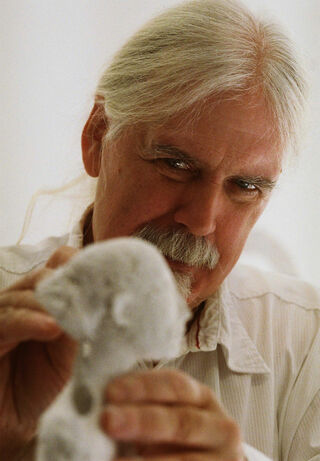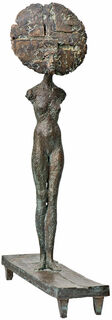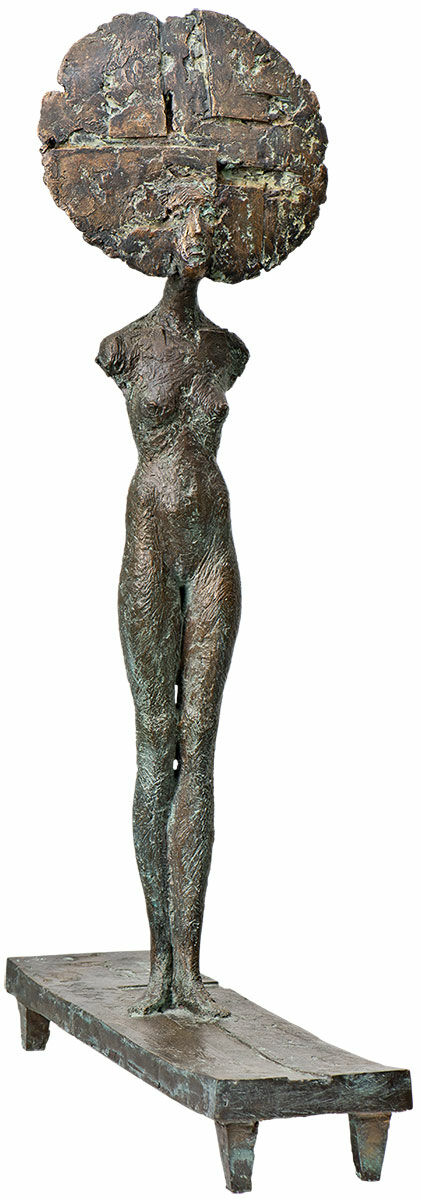Sculpture "Striding La Luna" (2017), bronze
Sculpture "Striding La Luna" (2017), bronze
Quick info
limited, 8 copies | numbered | monogrammed | hallmarked | bronze | chiselled | polished | patinated | size approx. 76 x 20 x 51 cm (h/w/d)
Detailed description
Sculpture "Striding La Luna" (2017), bronze
Sculpture in fine bronze, cast using the Lost-Wax-Process, chiselled by hand, polished and patinated. Limited edition of 8 copies, numbered, monogrammed and with the foundry hallmark. Size approx. 76 x 20 x 51 cm (h/w/d).

About Michael Jastram
The sculptor Michael Jastram (born 1953) has been an established name in German contemporary art for around 40 years. He has developed a very individual artistic form concept that always places the human figure at the centre of his work. Jastram places his figures in surreal constructs made of various, often recurring elements. He deliberately keeps the surfaces of his works rough with clearly recognisable traces of treatment. Jastram's sculptures are highly aesthetic objects, providing projection surfaces for existential and philosophical questions.
Michael Jastram studied at the Berlin-Weißensee Academy of Art and received his diploma as a sculptor in 1984. Since then, he has been working as a freelance artist and lecturer and shows his works in national and international galleries and museums. Many of his works can be found in public spaces and numerous collections. In 2010, the German Bundestag acquired Jastram's bronze sculpture "Europe and the Bull", which today stands on the presidency level in the Reichstag building in Berlin, as does the "Centaur". His bronze sculpture "Gateway to Europe" can be seen in the liaison office of the German Bundestag in Brussels.
An alloy of copper with other metals (especially with tin) used since ancient times.
When casting bronze, the artist usually applies the lost-wax technique which is dating back more than 5000 years. It's the best, but also the most complex method of producing sculptures.
First, the artist forms a model of his sculpture. It is embedded in a liquid silicone rubber mass. Once the material has solidified, the model is cut out. The liquid wax is poured into the negative mould. After cooling down, the wax cast is removed from the mould, provided with sprues and dipped into ceramic mass. The ceramic mass is hardened in a kiln, whereby the wax flows out (lost mould).
Now we finally have the negative form, into which the 1400° C hot molten bronze is poured. After the bronze had cooled down, the ceramic shell is broken off and the sculpture is revealed.
Now the sprues are removed, the surfaces are polished, patinated and numbered by the artist himself or, to his specifications, by a specialist. Thus, each casting becomes an original work.
For lower-quality bronze castings, the sand casting method is often used which, however, does not achieve the results of a more complex lost-wax technique in terms of surface characteristics and quality.
Term for an art object (sculpture, installation), which is produced in multiple copies in a limited and numbered edition according to the artist‘s will.
Artist's multiples have been called the most accessible and affordable art on the market.
A plastic work of sculptural art made of wood, stone, ivory, bronze or other metals.
While sculptures from wood, ivory or stone are made directly from the block of material, in bronze casting a working model is prepared at first. Usually, it is made of clay or other easily mouldable materials.
The prime time of sculpture after the Greek and Roman antiquity was the Renaissance. Impressionism gave a new impulse to the sculptural arts. Contemporary artists such as Jorg Immendorf, Andora, and Markus Lupertz also enriched sculptures with outstanding works.


